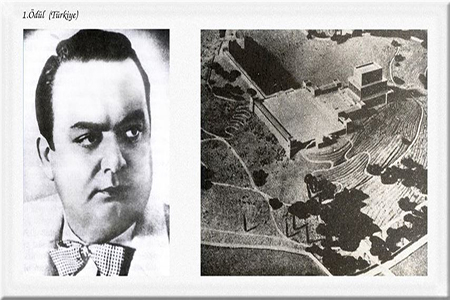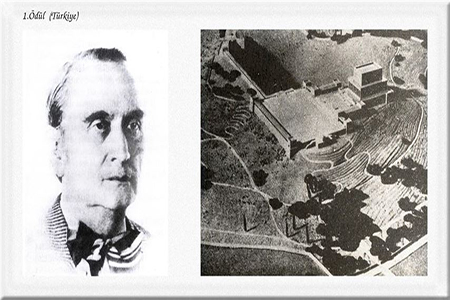Artists Who Contributed

EMİN ONAT (1908 – 1961)
Emin ONAT was born in İstanbul. He went to Beyazıd Primary school and Vefa High School. He started the School of Engineering in 1926. Completing his third year at the university, he went to the Zurich Technical University to complete his education and became a faculty member in his own school when he returned. He graduated from the Department of Architecture with the first degree in 1934. He respectively became an Associate Professor and Professor in 1935 and 1938 in the Department of Architecture of the University of Engineering. He became first in the international competition for the project of Anıtkabir. He became distinguished professor on March 28, 1943. He was elected an honorary member of the Royal Institute of British Architects. Starting from 1938, he worked as the chief of the Architecture Branch Office until the foundation of the Technical University. When the Technical University was founded in 1944, he was elected the first dean of the Department of Architecture. He served as a dean for two semesters and served as a rector between 1951 and 1953. He was awarded various citations on June 27, 1951 by the committee of the professors due to his great services for the development of the faculty and by the senate due to his contributions as a rector during his tenure.
Professor Emin Onat was given honorary degree by the Hannover Technische Hochshule in 1956 in honor of its 125th anniversary.He was elected MP in 1954 and served until 1957. He did not join 1957 elections and returned to his duty in the Faculty of Architecture.
In addition to his academic carrier, Emin Onat had many works including Anıtkabir, Faculty of Arts and Sciences of the University of İstanbul, İstanbul Courthouse, Central Building of İstanbul Technical University, Sanatorium of Uludağ and Ankara Police Station. Emin Onat died of a heart attack on July 17, 1961.

ORHAN ARDA (1911 - 2003)
Born on May 19, 1911 in Salonika Orhan ARDA went to primary, elementary and high schools in Istanbul. In 1936, he graduated from Senior Engineering School. In 1938, he was appointed as assistant to the Civil Engineering Department of the school he graduated from. On March 1, 1941 he participated in the competition launched for construction of Anıtkabir with Emin Onat and came first.
In 1944 Senior Engineering School became a university and he got the title of Associate Professor in the Faculty of Architecture. Until November 1953 he not only worked in his office at the university but also in construction sites.
In 1960, he was appointed as professor of Architecture Faculty, the Second Building Chair (a Turkish Title) of Istanbul Technical University (ITU). In a short time he became the head of the same chair. He also chaired the Architecture Faculty Environmental Analysis and Industrialized Building Design of ITU.
Hüseyin Özkan ANKA
Turkish sculptor Hüseyin Özkan ANKA was born in Dumurcalı, in 1909. He studied at the Fine Arts Academy (currently Mimar Sinan University). He became well-known for his monumental sculptures with an impressive technique. He improved a concept of figure remaining loyal to the ancient Greek style and produced stable and impressive sculptures with this inspiration.
Examples from his works: Atatürk’s Sculpture in Aydın, Atatürk’s Sculpture in Trabzon, Mimar Sinan’s Sculpture in the yard of Language and History-Geography Faculty. In Anıtkabir, The statue of the groups of three male figures in front of the Freedom Tower, The statue of the groups of three female figures in front of the Independence Tower The Road of Lions.Zühtü MÜRİDOĞLU
Turkish sculptor Zühtü MÜRİDOĞLU was born in 1906. Graduating from Sculpture Department of Sanayi-i Nefise, he attended Collarosi Academy in Paris. When he came back, first he worked as an art teacher and then the head of the General Directorate of Museums and the Chief of the Sculpture and Moulage Workshop of Istanbul.
Examples from his works: Atatürk’s sculpture in Zonguldak. In Anıtkabir; “Commander-in-Chief Pitched Battle Relief” on the left side of the stairs ascending to the Mauseloum, “Lad with a Sword and the Eagle Relief” inside the Tower of Independence, “ The Angel and a Rearing Horse Relief” in the Tower of Liberty, “Mehmetçik Relief” on the wall of the Tower of Mehmetçik.İlhan KOMAN
Turkish Sculptor İlhan KOMAN was born in Edirne, in 1920. He attended the Sculpture Department of Fine Arts Academy. He was a student of Proffessor Belling in Paris. In the first years of his career he created figurative sculptures, however, after 1948 he produced abstract works.
Examples from his works: - He has works in Istanbul Painting and Sculpture Museum and New York Modern Art Museum. - In Anıtkabir; “Sakarya Pitched Battle Relief” on the right side of the stairs ascending to the Mausoleum.Nusret SUMAN
Turkish Sculptor Nusret SUMAN was born in Salonika, on March 21, 1905. He made plain sculptures free from details. He graduated from the Sculpture Department of Sanayi-i Nefise (currently Mimar Sinan University). He was one of the four sculptors sent to Europe in the Republic Period. He worked as a lecturer in the Fine Arts Academy. Examples from his works:
The Hittite Sun in Ankara, The Sculpture of Mimar Sinan in İstanbul Painting and Sculpture Museum. In Anıtkabir; “ Hilt of a Sword and Four Hands Relief in the Tower of National Pact, “ Peace at Home, Peace in the World Relief” in the Tower of Peace, “ Torches Relief” in the Tower of Revolution, “Male Figure Relief” in the Defence of Rights Tower .Kenan YONTUNÇ
Turkish sculptor Kenan YONTUNÇ was born in 1904, in İstanbul. He attended Fine Arts Academy and taught in the same academy. He married to the daughter of General Kazım Sebüktekin, a close friend of Atatürk and took the chance to have a close contact with Atatürk in this way. One of his works the “Mask” (1938) he made with Atatürk’s permission is very successful in terms of similarity to Atatürk as well as of its interesting quality of plastic nature. He took great attention with his work and the replicas made of soil were distributed to everywhere.
Examples from his works: - He made the masks of Atatürk’s hands and face following his death. In Anıtkabir; the “Relief of Flag Pole Base”, “Relief of the Rostrum and the writing on it”, “Bird Houses” (in the whole monument).Hakkı ATAMULU
Turkish Sculptor Hakkı ATAMULU was born in Nevşehir in 1912. He attended the Sculpture Department of the Fine Arts Academy. He created monument-sculpture type works. Hakkı Atamulu is a master of material and has a powerful technique. In his figured works great crowds modeled cleanly were created with details. In addition firm and filled masses are dominant in his works.
Examples from his works: Damat İbrahim Pasha Monument in Nevşehir,
Atatürk and Erzurum Congress Monument in Erzurum.
In Anıtkabir; “Standing Woman and the Keys Relief” in 23 April Tower.
Emin BARIN
Turkish calligrapher and paperback expert Emin BARIN was born in Bolu in 1913. Graduating from Gazi Discipline Institute, he achieved success in the exam he took to study to be a qualified specialist in “printing press and printing block” and learned to make manual paperbacks in Germany. He also taught at Fine Arts Academy.
Examples from his works:
“Atatürk’s Speech on the 10th Anniversary of the foundation of the Republic” in the Entrance of the Honour Hall and
“Address to the Turkish Youth (completed this work with stonemason Sabri İltaş),
“İsmet İnönü’s Declaration to the Nation” and
“Atatürk’s Last Message to the Turkish Army” (completed this work with stonemason Mehmet Akgünler),
32 inscription blocks in various parts of Anıtkabir.
Tarık LEVENDOĞLU
Turkish stage designer (decorator) Tarık LEVENDOĞLU was born in İstanbul on September 9, 1913. He first studied painting at İstanbul State Fine Arts Academy and then won a scholarship to study stage designing at Brera Fine Arts Academy in Italy. He contributed to Ankara State Theatre’s works with the costumes and decoration he made since its foundation.
Examples from his works:
Decoration and Costume: Hotelkeeper Woman, Köroğlu, Aquarium and some other plays.
Plays he directed: Gönül Avcısı, Picnic in the Front, Aquarium etc.
In Anıtkabir: Frescos and Ornaments